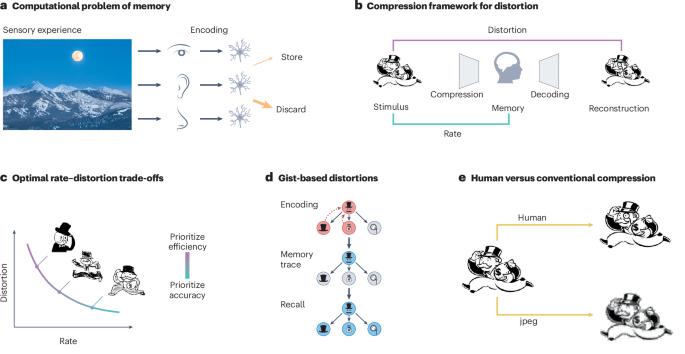Adaptive compression as a unifying framework for episodic and semantic memory
IF 21.8
Q1 PSYCHOLOGY, MULTIDISCIPLINARY
引用次数: 0
Abstract
Sensory experiences are encoded as memories, not as verbatim copies, but through interpretation and transformation. Rate distortion theory frames this process as compression in which irrelevant details are discarded. Despite the successes of approaches based on rate–distortion theory in aligning with empirical findings, these approaches assume that environmental regularities are known and unchanging and that surprising experiences are dismissed. However, the brain’s model of environmental regularities (semantic memory) is continually learned and refined, and surprising events have a pivotal role in this learning. In this Perspective, we offer a normative framework that addresses the interplay between semantic and episodic memory in the context of this computational problem that encompasses memory distortions, curriculum effects and prioritized replay. We propose to consider memory as solving an online structure learning problem, with semantic and episodic memory each having a role. We argue that semantic memory must learn the regularities that enable the efficient encoding of experience and that episodic memory supports this process by preserving surprising experiences in a relatively raw format for later interpretation. This framework opens up avenues towards understanding how adaptive compression and surprise shape the trajectory of learning and memory distortions. Memory cannot retain verbatim information about all experiences; some loss and compression is needed to meet resource constraints. In this Perspective, Nagy and colleagues describe a framework in which semantic memory encodes broad regularities and episodic memory retains specific information for key experiences.

自适应压缩作为情景和语义记忆的统一框架
感官体验被编码为记忆,不是逐字复制,而是通过解释和转换。速率失真理论将这一过程定义为压缩,其中不相关的细节被丢弃。尽管基于比率扭曲理论的方法在与实证结果一致方面取得了成功,但这些方法假设环境规律是已知的且不变的,并且排除了令人惊讶的经验。然而,大脑的环境规律模型(语义记忆)是不断学习和完善的,而意外事件在这种学习中起着关键作用。从这个角度来看,我们提供了一个规范性框架,解决了语义记忆和情景记忆之间的相互作用,在这个计算问题的背景下,包括记忆扭曲、课程效应和优先重播。我们建议将记忆视为解决在线结构学习问题,语义记忆和情景记忆各有其作用。我们认为语义记忆必须学习能够有效编码经验的规律,而情景记忆通过以相对原始的格式保存令人惊讶的经验以供以后解释来支持这一过程。这个框架为理解适应性压缩和惊奇如何塑造学习和记忆扭曲的轨迹开辟了途径。记忆不能保留所有经历的逐字信息;为了满足资源限制,需要进行一些损失和压缩。在这个观点中,Nagy和他的同事描述了一个框架,在这个框架中,语义记忆编码了广泛的规律,而情景记忆保留了关键经历的特定信息。
本文章由计算机程序翻译,如有差异,请以英文原文为准。
求助全文
约1分钟内获得全文
求助全文

 求助内容:
求助内容: 应助结果提醒方式:
应助结果提醒方式:


